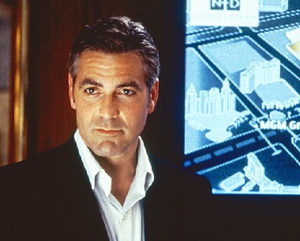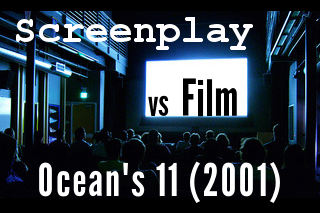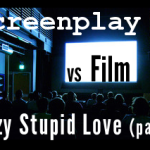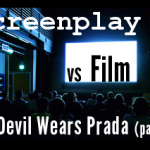The 2001 remake of OCEAN’S 11 was a fun, clever blockbuster which exuded charm.
Comparing the movie to the 1999 draft written by Ted Griffin also yields several screenwriting tips you can use right away to revise your script and make it as appealing as George Clooney.
These screenplay writing tips are all quick and simple to implement, but I’ve included TONS of examples straight from Ted Griffin’s 1999 script, so this article is fairly long. You might want to print it out first, or at least make sure your chair is in a comfortable position before you start reading!
To give you an idea of the screenplay revision tips I’m going to cover, here’s a list:
- Show once, don’t tell
- Begin a scene with motion
- Be careful with quirks
- Exit at the high point
- Embrace the interjection
- Setup isn’t always critical
- Everyone gets a turn
- Reevaluate your flashbacks
- Make your characters hurt
- Give the villain a clue
- Get real about your script’s ending
I have to say though, there is one aspect of Griffin’s script that you shouldn’t imitate–its length. It’s 145 pages long! As someone hoping to break into Hollywood, your scripts should conform to industry standards. Between 100-110 pages seems to be the current sweet spot.
In all other respects though, Ted Griffin’s script is a wonderful model for any aspiring screenwriter to study. So let’s dive in, shall we?
Screenplay Revision Tip #1: Show ONCE, don’t tell
So you’ve probably come across the rule of “show, don’t tell,” more than once in your screenwriting journey. While showing is usually better than telling, it comes with a huge drawback: it takes up more space.
Conserve your screenplay real estate by showing once, and then moving on–especially when you’re trying to convey key characteristics about your hero to the audience.
In the original screenplay draft of OCEAN’S 11 that I read, the beginning spends more time with Danny Ocean at his New Jersey prison than it did in the movie.
For example, it included this scene:
GUARD
(calling down hall)
49-J! Open!
The cell door slides open…
Inside the cell: Danny and another INMATE don’t budge; they sit haunched on opposing cots, a small table between them, squaring off over poker hands.
GUARD
Let’s go! Eighteen months ain’t enough for you?
Danny raises a hand to silence him.
DANNY
One card.
The Inmate eyes Danny warily, then deals the top card…
The queen of diamonds. Danny smiles — all business, no gloating — and spreads his hand out.
INMATE
You caught the straight inside.
DANNY
It’s my lucky day.
He stands, straightens his prison jumper, collects the playing cards…
DANNY
So long, Eskimo.
INMATE
So long, kid. Go hang yourself.
Danny steps out to meet the Guard…
DANNY
Thanks for waiting.
This scene tells us something critical about our charming hero–he loves playing the game for the game itself. He can’t walk away from it, even when freedom is at his fingertips. It’s a wonderful example of showing rather than telling.
But is it necessary?
After Ocean leaves prison, the first thing he does is visit a casino. Later on, leaves the state to meet up with his former con partner, Rusty. Taken in combination, don’t these actions tell us the same thing as the scene in the prison cell?
What a man does immediately after he’s released from prison tells us something about what he values. Ocean’s first action is to get to work on another con (stealing money from 3 casinos owned by Terry Benedict) which could jeopardize his newly-gained freedom.
If Ocean is so willing to risk his freedom, clearly he can’t walk away from the con game. It’s in his blood, it’s who he is.
If you were in the middle of revising a script beginning like this one, and you realized that you had shown the audience the same thing twice, how would you know which scene to keep and which one to cut? The answer’s really quite simple.
If you cut the card game scene, the story still moves forward.
If you cut the visit to the casino…well the story could still move forward, but you’d lose the introduction to Frank, who’ll eventually become one of Ocean’s crew. But if you cut Ocean’s visit to Rusty, the whole plot comes to a screeching halt.
The visit to the casino and the visit to Rusty accomplish multiple story objectives. But the card game scene at the prison cell only accomplishes one. That’s why it should end up on the cutting room floor.
Screenplay Revision Tip #2: Begin a scene with motion
Movies are made to showcase movement, so try your best to interject as much motion as possible into your scenes.
This doesn’t mean your characters should morph into kinetic bouncing balls. But at the very least, try to have them walk towards their destination before they take a seat. This is probably best explained via example, so here goes:
In both the screenplay draft of OCEAN’S 11 that I read and the movie released in theaters, we meet Daniel Ocean’s right-hand man, Rusty, at a poker game. But there’s a subtle difference in the way the scene begins.
In the script, the scene starts with Rusty, a movie star named Kyle, and unnamed poker players seated at a poker table set up in Rusty’s hotel room.
In the movie, Rusty first meets up with a famous actor (in a sweet cameo by Topher Grace) at a crowded bar, and they walk together towards a poker table set up in a backroom.
This difference is effective in two main ways. One, the majority of the rest of the scene will take place at the poker table. That’s a lot of sitting down…which can get boring to watch.
Walking towards the poker table prevents the scene from being too static and sedentary. (For another example of meeting in motion, check out screenwriting tip #1 from HITCH.)
Two, the poker table is populated by a bunch of clueless actors (in more sweet cameos).
By having Rusty meet Topher first, and then having them walk to the poker table together, the audience has time to process who Topher is before their minds get bombarded with introductions to a bunch of other characters.
With the exception of the Malloy twins, notice that the movie introduces each member of Ocean’s crew one at a time, in separate scenes. This not only makes the story more fun; it also makes it easier to understand. This is a key point to remember when you’re revising your own screenplay.
If you’d like to learn more about hero introduction lessons, read this.
Screenplay Revision Tip #3: Be careful with quirks
All of your main characters should have distinct personalities and characteristics. But in an attempt to make your characters distinctive, you may make them absurdly quirky. You may be trying too hard.
For example, in the screenplay draft of OCEAN’S 11, the hacker on Ocean’s crew wasn’t just a genius with computers. He was a one-armed genius!
Take a look:
…Roscoe Means, audio-visual junkie, cigarette dangling perennially from his lips, crouches before their image, masterfully controlling his surveillance camera with a joystick in his left hand. He is flanked by FBI MEN.
[…]
EXT. BUSY BOULEVARD – LATER
Roscoe looks both ways, then jaywalks across a boulevard, pushing toward a cafe, and for the first time we notice: Roscoe only has a left arm. His right sleeve tucked into his belt, he manages to work, type, drink and eat all with his left hand, and always while smoking.
In the movie, Roscoe was renamed Livingston. More importantly, he had two functioning arms. Instead of using a handicap to distinguish him from the rest of the gang, the movie gave him the trait of extreme nervousness. This not only contrasted nicely with Ocean and Rusty’s confidence, it also made Livingston distinctive without being over the top.
Plus, if you’re pulling a con, you need to assemble a crew composed of people who can blend into a crowd. A one-armed genius would definitely call attention to himself, jeopardizing the chances of successfully pulling off the heist.
On completely random side note, I can’t believe screenwriter Ted Griffin seems to despise the Oxford comma! Doesn’t he know it’s the coolest punctuation mark since the semi-colon?
Screenplay Revision Tip #4: Exit at the high point
Like “show, don’t tell,” you’ve probably come across the screenwriting maxim, “come in late, get out early.” Let’s focus on the latter half of that guideline: getting out early.
Once you’ve reached the apex of a scene, don’t dawdle. Jump into the next one.
Again, this is more easily expressed via example. Here’s an excerpt from the script in which Rusty rescues Basher, an explosives expert, from arrest:
The Cop looks bewildered. Rusty steps forward, yanks Basher onto his feet, spins him around. He moves his hands up and down Basher’s legs, around his waist, under his arms.
RUSTY
Will you go find Griggs and tell him I need to see him?
COP
Who?
RUSTY
Just go find him, will you?
(as Cop stalks off; under his breath)
How fast can you put something together with what I passed you?
[…]
And behind them a squad CAR ERUPTS with a BANG!
[…]
IN ALLEY – MOMENTS LATER
A CAR SCREECHES to a halt and Rusty and Basher jump in the back. Danny is driving.
DANNY
How you doin’ Basher?
BASHER
Well, Danny. Yourself?
DANNY
Listen, let’s do this shorthand. I’ve got a favor coming, I figure.
BASHER
Under the circumstances, that would seem fair, yes.
(spotting approaching cops)
Perhaps, if we drove a spell, you might apprise me at greater length.
Danny shoots him a smile, then hits the gas.
BASHER
Cheers. Care to tell me where we’re headed?
RUSTY
Las Vegas.
BASHER
Oh, splendid! Catch a show, can we?
In the movie, the scene ends with Rusty and Basher running away after the explosion. The chit-chat in the car was eliminated completely.
This was a wise choice because the conversation in the car doesn’t add anything to the story. Although the banter is funny, it doesn’t have the sly wit of the rescue attempt.
In fact, because the humor isn’t of the same caliber, it dilutes that wit. To quote the writing guide Self-Editing for Fiction Writers:
1 + 1 = 1/2.
Notice, however, that this principle usually applies to comedic moments of action which are followed by dialogue. If you’re writing a straight-up action scene which is full of pure action–and no humor–an ironic understatement made by one of your characters may be the perfect way to cap the scene.
Comb through the screenplay you’re trying to revise right now and look for comedic moments of action which end a scene. Do you tack on dialogue afterwards? Does this dialogue actually enhance the humor–or does it undercut it?
Screenplay Revision Tip #5: Embrace the interjection
For the most part, you should avoid having one character deliver a long monologue in your script. Although, to be fair, I’ve heard of actors signing on to a role just to deliver a particularly juicy monologue.
But, if you’re not writing a long speech as actorbait (and you should be very careful with this tactic), try to trim it down.
You can do that by eliminating half of it altogether (see screenplay cutting technique #1 in How to Cut Your Screenplay by 25 Pages). Alternately, you could break up the speech into smaller parts and reassign chunks of dialogue to other characters.
Sometimes though, you can’t eliminate parts of the speech because the audience needs to know ALL of the information in order to understand what happens next.
Additionally, you might not want to reassign the dialogue to another character, because you want to keep the person who’s delivering the speech in the driver’s seat.
For example, look at the excerpt below. In it, Danny Ocean explains to his crew his plan to rob Terry Benedict’s casinos. It can’t be trimmed down because all of it is essential.

With helpful interjections from Rusty, Ocean explains details of the heist
Technically, Ocean’s monologue could have been broken up, split between him and Rusty, but that would’ve removed the spotlight from Ocean. (Ignore the red lines for the moment)…
DANNY
Okay. Bad news first. This place houses a security system which rivals most nuclear missile silos. First: we have to get within the casino cages — here, here and here — which anyone knows takes more than a smile. Next: through these doors, each of which requires a different six-digit code changed every twelve hours. Past those lies the elevator, and this is where it gets tricky–the elevator won’t move without authorized fingerprint identification, which we can’t fake, and vocal confirmations from both the security center within the Versailles and the vault below, which we won’t get. Furthermore, the elevator shaft is rigged with motion detectors, so if we manually override the lift, the shaft’s exit will lock down automatically and we’ll be trapped. Once we’ve gotten down the shaft, though, then it’s a walk in the park: just three more guards with Uzis and predilections toward not being robbed, and the most elaborate vault door conceived by man. Any questions?
If you compare the screenplay of OCEAN’S 11 to the film, Danny Ocean delivers the same speech verbatim. There’s only one major difference–Rusty makes periodic interjections (which are noted by a thin, red underline in the excerpt above).
These interjections break up Ocean’s speech, preventing it from becoming too monotonous, while still keeping the focus squarely on Ocean.
The interjection. Embrace it!
Screenplay Revision Tip #6: Setup isn’t always critical
Setups and payoffs are one of the best tools in your screenwriting bag of tricks. A well-executed setup can make contrived scenes appear natural and outlandish events seem credible. Once you’ve mastered the skill of planting setups, you might be tempted to use them all the time.
But sometimes, the setup isn’t really necessary and is just a waste of your limited screenplay real estate. Here are two examples from OCEAN’S 11 to show you what I mean.
Ocean’s 11 Example #1: the hooker flyers
Do you remember the end of OCEAN’S 11? Benedict has sent his men to chase down a white, unmarked van which supposedly contains cash stolen from Benedict’s casinos. But the bags explode, revealing that they weren’t filled with money…but with prostitute promotional materials.
The script had the same scene, only it set up the hooker flyers in advance. From page 46:
EXT. STRATOSPHERE OBSERVATION DECK – NIGHT
One hundred thirty stories high, the Stratosphere Needle offers a $4.95-all-you-can-see view of Las Vegas, including the Strip, the airport and the surrounding desert. As a promoter hands out fliers for strip joints and call girls (as seen at almost every corner of the Strip)…
…the entire gang — Danny, Rusty, Linus, Saul, Basher, Roscoe, Yen, Frank, Virgil, Turk and Tishkoff — case the city from here, their fingers silhouetted against several thousand lights. Tishkoff steals the fliers away from the promoter.
[REUBEN] TISHKOFF
What are you…there are kids up here…
(shooing the promoter away, to Frank)
In my day we kept hookers where they belonged. In the lounge.
This is Vegas, baby! Prostitution abounds. There’s no need to set up the hooker flyers because their presence is something the audience would automatically accept.
Their existence doesn’t strain credibility at all, and the setup scene is completely unnecessary.
Ocean’s 11 Example #2: Bruiser
In a clever twist, part of Ocean’s post-heist escape plan is to…get caught. He purposefully calls attention to himself, knowing that Benedict will retaliate by calling in “muscle” to punish him.
In the movie, two of Benedict’s goons lock Ocean in a room without cameras to record the carnage. He only gets one visitor–a scary looking dude appropriately named Bruiser.
Because OCEAN’S 11 is all about the con, Bruiser isn’t there to hurt Ocean. In fact, Bruiser and Ocean are well-acquainted, and Bruiser’s involvement is actually a part of Ocean’s master plan.
Surprise!
However, in the script, Bruiser’s appearance wasn’t a surprise. It had been set up, not once…but twice. Here’s the first time:
HOUSEWIFE
Hold on, Sandy.
(to Danny)
Yes?
DANNY
Good morning. Is Leland Sikes at home, please?
HOUSEWIFE
(wailing over her shoulder, to her half-seen, enormous husband in the next room)
Bruiser! You gotta visitor!
…and the second…
ON BALCONY OVERLOOKING CASINO FLOOR
Benedict meets his casino Manager, according to schedule.
BENEDICT
Any sign of Ocean?
MANAGER (WALSH)
Not in a couple hours. You want him out? I can bounce him from the state for parole violation if you like.
BENEDICT
(shakes his head)
Put a guy on him. He’s here for a reason. I’d like to know what it is.
(a puff of cigar)
But if he comes anywhere near Tess, I want him to feel pain.
MANAGER
Bruiser?
Benedict nods, goes on his way.
By setting up Bruiser in advance, the script overcame a credibility hurdle. But at the same time, it diluted the script’s charm and the audience’s overall enjoyment. In this case, it was better to eliminate the setup altogether in order to maintain the surprise when Bruiser and Danny’s pre-existing friendship is revealed.
OCEAN’S gets away with this primarily because it is a con movie. If Ocean has a few tricks up his sleeve that he’s kept hidden, we don’t begrudge him those. We gladly accept that he may know more than he’s letting on, and when he does reveal that knowledge, we won’t cry foul or criticize the film’s credibility.
You’ll notice that SHERLOCK HOLMES and SHERLOCK HOLMES 2: GAME OF SHADOWS employ the same tactic.
In your own screenplay, you might be able to get away with it too. So when you’re revising your script, make sure that all of your carefully planted setups actually enhance your story and increase audience enjoyment.
Screenplay Revision Tip #7: Everyone gets a turn
Remember elementary school? All the kids would sit in a circle, and the teacher would make sure everyone–not just the brown-noser or the bully–got a turn to speak.
When you’re writing a script which requires a fairly large cast, you want to use a similar approach. Like timid grade-schoolers, it’s easy for some of your supporting characters to get lost in the crowd. To avoid this, make sure that you’ve divvied up scenes equitably.
In other words, scenes and lines for the supporting cast should be distributed evenly, but also according to order of importance.
In OCEAN’S 11, for example, Ocean and Rusty are clearly the lead players. They’re going to have more scenes and lines than the others in Ocean’s con man crew. Even though Linus isn’t as big of a player as Rusty, he too is going to have more scenes and lines than the others. The same applies to Saul.
But the rest of the cast…Basher, Frank, Yen, the Malloy twins…they’re pretty much in the same tier. There should be balance between them; one shouldn’t overshadow the other.
In the screenplay draft I read, the perfect balance hadn’t yet been struck. Take this scene at the car dealership. In the script, the focus is all on the Malloy twins:
EXT. LAS VEGAS VAN AND TRUCK DEALERSHIP – DAY
A car dealer greets Turk, Virgil, and Frank, and as Frank acts as negotiator for the trio, Turk and Virgil go to work: sticking their heads under hoods, jumping up and down on bumpers, sneaking under trucks’ bellies, etc.
DANNY (V.O.)
Virgil, Turk, you’ll be driving us out of this mess. I don’t want to hear gears grinding as we speed down Las Vegas Boulevard.
SAME SCENE – LATER
Turk and Virgil prepare for a test drive. They REV a truck’s ENGINE way, way, up as the car dealer sits between them, scared s***less.
TURK (V.O.)
Don’t worry about us, Danny. We’re very quiet drivers.
And — SQUEEEEEALLLLL — they BURN RUBBER ten yards off the dealership lot as Frank waves: Have a nice time.
While the scene says Frank negotiates, his dialogue isn’t written out. It looks like Frank has no lines, that he’s only a two-bit player. In the movie, Frank doesn’t wave from the sidelines. No, he had lines, great lines about his search for the perfect moisturizer.
Without the addition of those lines, Frank doesn’t have a moment to shine during the first half of Act Two. You’re not going to attract an actor/comedian like Bernie Mac that way.
In the same vein, if you have a large cast, you should minimize introducing “outside” characters as much as possible. Outside characters usually only appear in one scene to add to the humor, to explain information for the audience’s benefit, or to add realism to a scene (ie a hot dog vendor at a baseball game).
In the screenplay draft of OCEAN’S 11 I read, the outside character comes in the form of a physics professor. Danny asks Basher, “What is a pinch?” and then we cut to a lecture hall where a physics professor makes the requisite explanation.
His speech runs about 35 lines long.
35 lines!
35 lines–squandered on a character we’ll never see again. In the movie, these lines were kept “in-house” and assigned to Basher, giving actor Don Cheadle more to work with.
To sum it up, in regards to screentime and lines of dialogue, be generous to your main cast, but be stingy with outsiders. (For more examples of this tip in action, check out screenwriting tips #3 and #5 from The Devil Wears Prada.)
Screenwriting Tip #8: Reevaluate your flashbacks
Like slick car salesmen, flashbacks have an unsavory reputation in the screenwriting world. That reputation is usually well-deserved.
Oftentimes, in feature-length films, flashbacks fall flat. They end up dragging down your story.
Take this example from OCEAN’S 11. Tess, Ocean’s ex-wife, remembers semi-better days:
FLASHBACK – INT. MANHATTAN SUPPER CLUB – NIGHT (TWO YEARS EARLIER)
Tess’s hand (wearing her silver band) meets Danny’s (wearing his) over a candlelit dinner. The whole room, in memory, sparkles. It’s hard not to be in love at this table.
DANNY
Happy anniversary, Mrs Ocean.
TESS
Happy anniversary, Mr Ocean.
DANNY
Happy?
She smiles at him, beaming, and this time she obviously is.
WAITER
(seen from the chest down)
Mr Ocean…
DANNY
(without looking up)
We’ll take the check now.
VOICE (O.S.)
This one is on us.
Danny peers up. The Waiter is flanked by two DETECTIVES and three uniformed cops.
LEAD DETECTIVE
Daniel Ocean, we have a warrant for your arrest. You have the right to remain silent…
DANNY
C’mon, fellas. Not tonight…
LEAD DETECTIVE
(not without sympathy)
We waited til you finished your crème brulée.
(then, continuing)
You have the right to an attorney…
The cops pick Danny out of his seat and haul him politely away.
TESS
(horrified)
Danny?
DANNY
(over his shoulder)
Tess, I’m sorry.
We’re PULLED AWAY by the cops, too, AWAY FROM Tess, leaving her stranded at her anniversary dinner, her heart shattered…
This is a powerful scene. The timing of the arrest with the anniversary is genius. If it were a part of the script’s present-day timeline, it should’ve been kept for sure. But the scene is taken from events which unfolded long before the script began.
True, the scene does help us understand Tess’s feelings towards Ocean. But that’s not necessary, not when we witness Tess and Ocean’s first interaction at Benedict’s casino.
Her words are cutting and sharp; his are conciliatory. Their exchange tells us everything we need to know.
That’s not to say all flashbacks are unnecessary. OCEAN’S 11–both the screenplay draft and the movie–make fantastic use of them at the end to show how the con was perpetuated. Then, the flashbacks are warranted because they enhance the audience’s experience.
When you wrote your first draft of your script, you were probably convinced that all of your flashback scenes were truly essential. Now, during your revision period of writing, it’s time to assess them with a critical eye.
Are they warranted like the final flashback scenes in OCEAN’S 11? Or do they drag down your story momentum like the flashback to Tess and Ocean’s anniversary?
Screenplay Revision Tip #9: Make your characters hurt
Most writers don’t hurt their characters enough at the end of Act Two. They give their heroes paper cuts instead of Ginsu knife wounds.
If you look at your own screenplay, your hero is probably in a major predicament at the end of Act Two. Find a way to make his predicament, his pain, even worse.
Here are a couple of examples from OCEAN’S 11 to show you what I mean. The first one involves Saul. In order to pull off the heist, the aging con man has to pretend that he’s an international arms dealer named Zerga. In the screenplay, although Saul’s nervous, he manages to accomplish his goal with relative ease.
In the movie, however, his success was put into major jeopardy. As he’s walking through the Bellagio with Terry Benedict, one of Saul’s old acquaintances almost blows Saul’s cover.
To quote from the movie, “Saul! Saul Bloom, is that you? Saul! Saul, it’s me! Bucky Buchanan! Remember, from Saratoga?”
It’s a brief moment (only 10 seconds long), but it puts the entire heist in jeopardy. It puts Saul through the ringer. It gives Act Two a little more zing.
The second example involves Yen, “the grease man.” In the screenplay draft of OCEAN’S 11, Yen pretty much glides through his scenes like the amazing acrobat he is. In the movie version of OCEAN’S 11, he has more difficulties.
First, Yen injures his hand when Danny and crew steal the pinch (described in screenwriting tip #7). Towards the end of Act Two, after he’s been smuggled inside of the Bellagio’s vault, Yen adheres plastic explosives onto one side of the vault’s doors. Meanwhile, Ocean and Linus place some sort of corresponding explosive on the other side of the vault door.
Yen’s about to pull away, when the bandages encircling Yen’s injured hand get caught inside the doors. Yen is stuck–and Ocean is about to blow the door open.
It’s a really tense moment which not only puts Yen through the ringer–it keeps the audience in suspense too. Again, by intensifying Yen’s predicament, the end of Act Two has a little more zing.
Of course, the definition of “hurt” depends on what kind of story you’re telling. A knife wound in a lighthearted caper like OCEAN’S 11 would be the equivalent of a paper cut in a thriller like Casino Royale.
If you really want to end Act Two with maximum impact, when you revise your script, find ways to intensify your hero’s pain which are also appropriate for the kind of story you’re telling.
I’ve been doing a lot of study on this topic lately, and I really believe this is one of the best and easiest ways to take your screenplay to the next level.
To learn how to end your second act with maximum impact, read this »
Screenplay Revision Tip #10: Give the villain a clue
Your villain should be a badass, otherwise your story’s going to be boring. There are many different ways to be badass, but one way is to give your villain a clue. He’s always the smartest guy in the room. (Except when he’s facing your hero. Then it’s a close call.)
If there’s a knotty problem which needs unraveling, your villain–not his underlings–should be the one to figure it out.
At the end of OCEAN’S 11, we know that Ocean and his men have successfully pulled off the heist, but we’re still not sure how it was done. In the screenplay draft, neither was Terry Benedict. His casino manager and a security guard explained it to him.
Note: the casinos had different names in the script. Versailles = the Bellagio.
INT. VERSAILLES SECURITY CENTER – EYE IN THE SKY
Walsh stands before several monitors as Slim points out a discrepancy between the “masked men robbing the vault” image of a few minutes ago and the present image: the word “Versailles” appears along one vault wall in the new image, but not in the earlier one.
SLIM
(to Walsh)
Remember: we had that engraved on Tuesday.
WALSH
(on walkie-talkie)
Sir, we believe the image we saw of the men robbing us…it was a tape.
BENEDICT (V.O.)
What?
WALSH
It looks like someone built a double of the vault, then made a tape of them robbing it. When we saw them putting the money in those bags, that wasn’t actually happening. In fact, everything we saw on the monitors was bogus.
INT. VERSAILLES VAULT – NIGHT
Benedict, realizing how much he’s been duped, really starts to lose his cool.
BENEDICT
Then what happened to all my money?!
In the movie, Benedict was the one who figured it out and explained it to his casino manager (and by extension to the audience). It’s a subtle switch, but it makes a big difference.
When the casino manager has to explain everything to Benedict, it makes Benedict look stupid in comparison. It undercuts his villainy (yes, dictionary snob, that’s a word).
If you’re looking for another way to boost your villain’s badass quotient, read screenwriting tip #4 from SNOW WHITE AND THE HUNTSMAN.
Screenplay Revision Tip #11: Get real about your script’s ending
We all get the urge to march to the beat of our own drummers, but sometimes, the wisest choice is the tried and true way. Okay, I’ll stop sounding like a Chinese fortune cookie and explain what I mean.
Most screenplays end happily. You may get the urge to buck that trend. One way to satisfy your artistic spirit while maintaining commercial appeal is to compromise.
Your hero gets the gold or the girl, but not both.
That’s the way the screenplay draft of OCEAN’S 11 ended:
DANNY
(smiles at her)
You wanna get married again? Now?
(as she reacts)
I mean, when are we gonna be in Vegas again?
Tess stares at Danny, studying him; she smiles and says…
TESS
No. Danny, I told you: no matter how big the score, I wasn’t coming back.
[…]
TESS
(kisses him)
I’m sorry, Danny. I’m not coming back. To you or to him.
[…]
And she strolls away, a vision.
That ending is different. I certainly wasn’t expecting it. But is it really likely?
Is there really a woman who could resist the charm of Danny Ocean? Of Danny Ocean in an Armani tux? Of Danny Ocean in an Armani tux, with a bank account full of millions, begging her to come back to him?
Puh-lease.
Margaret Thatcher in her Iron Fist heyday wouldn’t be able to resist Danny Ocean. All that iron would melt.
This ending is different and unexpected, but it wasn’t very satisfying. Worse, it wasn’t believable.
Whenever you’re inclined to tinker with your hero’s happy ending, keep this tip in mind. Are you being different just for the sake of being different? Or do you think your ending is the best way to do justice to your story?
Final thoughts
OCEAN’S 11–both the script and the movie–were clever and witty. It’s no wonder Hollywood.com included the flick in its collection of top ensemble films.
Still, the movie diverged from the script a number of times, and each change took a great concept and made it even better. If you follow the screenwriting tips outlined in this article when you revise your own screenplay, it could mean the difference between a pass and a sale.
If you’d like to develop your screenwriting skills by studying OCEAN’S 11 even more, check out this interview with screenwriter Ted Griffin:
You can also read a copy of the film’s shooting draft. (Just to be clear, this isn’t the draft I used to compare to the movie.)
May Lady Luck bless your script revisions!
Watching a blank screen (with modifications) by Kenneth Lu




















